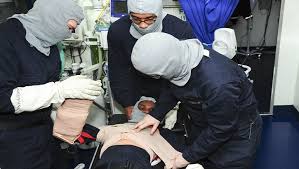Herculean efforts are being made by scientists around the world to respond quickly to the COVID-19 crisis in a race to understand the virus causing the pandemic and develop diagnostics, vaccines, and therapeutics. But many research questions remain. How can long-read SMRT Sequencing technology help fill the gaps?
PacBio microbiology expert Meredith Ashby highlighted several opportunities to support coronavirus research in a recent webinar as part of a day-long virtual conference hosted by LabRoots.
Sequencing the viral genome
 Understanding the basic biology of the virus is essential, and the more detailed our investigation, the better.
Understanding the basic biology of the virus is essential, and the more detailed our investigation, the better.
Highly accurate, long-read sequencing of viral genomes has for years been used by virus researchers to access information that is challenging to resolve with short-read data. Mutation phasing and the detection of rare variants are both greatly simplified when entire viral genes or genomes can be sequenced in a single molecule, Ashby said.
This phasing information allows researchers to understand if there are mutational hotspots or regions of stability, both of which are important to understanding how to design a vaccine or therapeutic. Better phasing also allows researchers to understand how and how fast the virus evolves, either within one person during the course of an infection, or over time during the course of an outbreak or epidemic. In the context of the current coronavirus pandemic, Ashby said, having high-quality sequencing information can help track whether the virus evolves in such a way that test quality is compromised, as well as monitor whether drug resistance arises once therapeutics are developed.
To illustrate these points, Ashby discussed several examples of researchers using PacBio technology to gain unique insights into the biology of other viruses, including HIV and influenza. In one example from HIV research, scientists were able to determine that two distinct strains of the env gene had arisen in a single patient, and that one strain was compartmentalized in brain tissues. In another example from influenza research, combining PacBio and single-cell sequencing gave a comprehensively detailed view of how viral mutations evolved over the course of an infection, revealing both point mutations and indels.
Why do some people get so sick while others do not?
 The answer to this question likely lies within the complex workings of our immune systems, which are still not completely understood. Ashby discussed how many of the regions of the genome that are involved in the immune response are highly polymorphic, and in the past have been quite challenging to sequence and to phase. These include the immunoglobulin heavy-chain (IGH) locus and the human leukocyte antigen (HLA) genes. In addition, long reads also offer several advantages for sequencing B cell receptor (BCR) repertoires.
The answer to this question likely lies within the complex workings of our immune systems, which are still not completely understood. Ashby discussed how many of the regions of the genome that are involved in the immune response are highly polymorphic, and in the past have been quite challenging to sequence and to phase. These include the immunoglobulin heavy-chain (IGH) locus and the human leukocyte antigen (HLA) genes. In addition, long reads also offer several advantages for sequencing B cell receptor (BCR) repertoires.
BCR sequencing can help us identify broadly neutralizing antibodies in recovered patients, which could then be used as interim treatments ahead of the development of a vaccine. Ashby described how using a long-read approach allows sequencing of the entire BCR transcript, including those regions outside the CDR3 domain where mutations can arise during somatic hypermutation.
 In addition, full-length sequencing allows for a simplified PCR reaction, which can avoid known issues with primer bias in the commonly used highly-mulitplexed short amplicon PCR strategy. Finally, Ashby discussed how one reason to sequence the immune repertoire, inference of the IGH locus, can instead be accomplished by direct sequencing with PacBio long reads.
In addition, full-length sequencing allows for a simplified PCR reaction, which can avoid known issues with primer bias in the commonly used highly-mulitplexed short amplicon PCR strategy. Finally, Ashby discussed how one reason to sequence the immune repertoire, inference of the IGH locus, can instead be accomplished by direct sequencing with PacBio long reads.
The ability to delve deeply into germline sequences and examine allelic differences from person to person could shed light on how the genetic background of patients may influence disease susceptibility, progression and outcomes.
Watch the webinar for examples of relevant research and more detailed application uses:
Interested in applying SMRT Sequencing in your COVID-19 research? Protocols, assay development recommendations, primer sources, workflows and checklists are available on the continually updated COVID-19 Sequencing Tools and Resources page.
Need to find a sequencing center? Connect with us and we’ll put you in contact with the closest service provider that is operational during the pandemic.